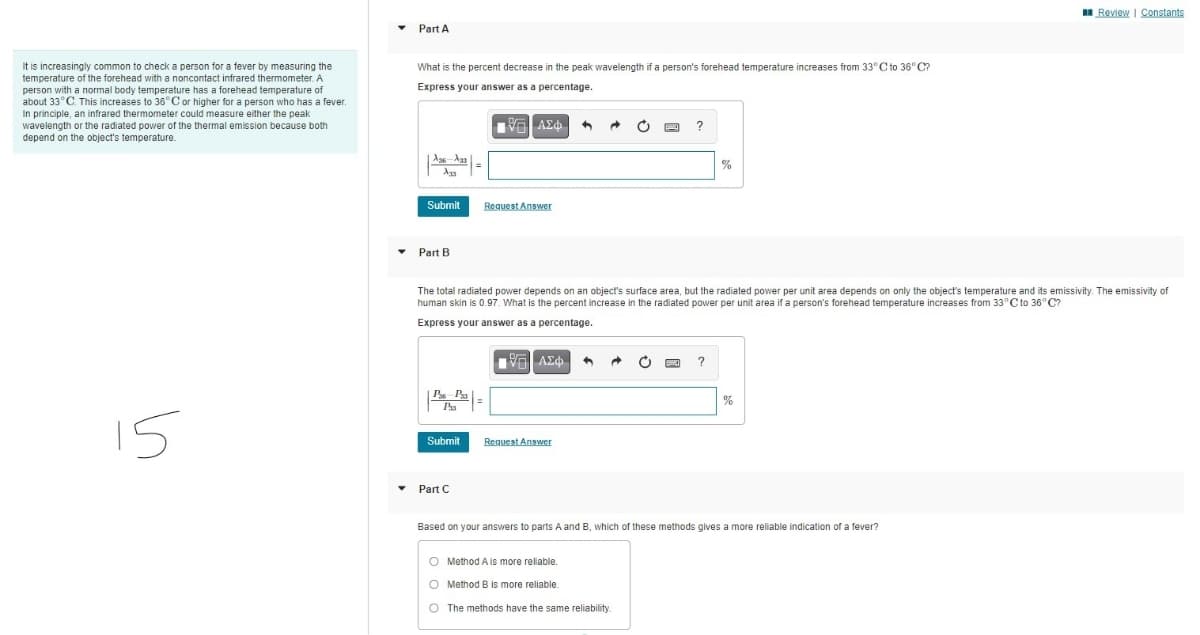I Review I Constants Part A It is increasingly common to check a person for a fever by measuring the temperature of the forehead with a noncontact infrared thermometer. A person with a normal body temperature has a forehead temperature of about 33°C. This increases to 36°C or higher for a person who has a fever. In principle, an infrared thermometer could measure either the peak wavelength or the radiated power of the thermal emission because both depend on the object's temperature. What is the percent decrease in the peak wavelength if a person's forehead temperature increases from 33° C to 36° C? Express your answer as a percentage. ? % Submit Request Answer Part B The total radiated power depends on an object's surface area, but the radiated power per unit area depends on only the object's temperature and its emissivity. The emissivity of human skin is 0.97. What is the percent increase in the radiated power per unit area if a person's forehead temperature increases from 33°C to 36°C? Express your answer as a percentage. AEO 15 Submit Request Answer Part C Based on your answers to parts A and B, which of these methods gives a more reliable indication of a fever?
I Review I Constants Part A It is increasingly common to check a person for a fever by measuring the temperature of the forehead with a noncontact infrared thermometer. A person with a normal body temperature has a forehead temperature of about 33°C. This increases to 36°C or higher for a person who has a fever. In principle, an infrared thermometer could measure either the peak wavelength or the radiated power of the thermal emission because both depend on the object's temperature. What is the percent decrease in the peak wavelength if a person's forehead temperature increases from 33° C to 36° C? Express your answer as a percentage. ? % Submit Request Answer Part B The total radiated power depends on an object's surface area, but the radiated power per unit area depends on only the object's temperature and its emissivity. The emissivity of human skin is 0.97. What is the percent increase in the radiated power per unit area if a person's forehead temperature increases from 33°C to 36°C? Express your answer as a percentage. AEO 15 Submit Request Answer Part C Based on your answers to parts A and B, which of these methods gives a more reliable indication of a fever?
Related questions
Question

Transcribed Image Text:I Review I Constants
Part A
It is increasingly common to check a person for a fever by measuring the
temperature of the forehead with a noncontact infrared thermometer. A
person with a normal body temperature has a forehead temperature of
about 33°C. This increases to 36°C or higher for a person who has a fever.
In principle, an infrared thermometer could measure either the peak
wavelength or the radiated power of the thermal emission because both
depend on the object's temperature.
What is the percent decrease in the peak wavelength if a person's forehead temperature increases from 33° C to 36° C?
Express your answer as a percentage.
?
%
Submit
Request Answer
Part B
The total radiated power depends on an object's surface area, but the radiated power per unit area depends on only the object's temperature and its emissivity. The emissivity of
human skin is 0.97. What is the percent increase in the radiated power per unit area if a person's forehead temperature increases from 33°C to 36° C?
Express your answer as a percentage.
?
15
Submit
Request Answer
Part C
Based on your answers to parts A and B, which of these methods gives a more reliable indication of a fever?
O Method A is more reliable.
O Method B is more reliable.
O The methods have the same reliability
Expert Solution
This question has been solved!
Explore an expertly crafted, step-by-step solution for a thorough understanding of key concepts.
This is a popular solution!
Trending now
This is a popular solution!
Step by step
Solved in 2 steps with 2 images
